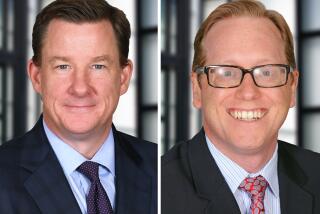Lawyer Survival : Competition, Lean Times Have Attorneys Talking to Marketing Experts
- Share via
NEWPORT BEACH — Even the lawyers agree that there are too many lawyers.
Competition and lean times have attorneys talking about survival, and a group of marketing experts from Western states met in Newport Beach late last week to discuss how law firms can adapt.
One marketing director said her efforts during the last two years will bring an additional $5.2 million into the firm in the near future. Another speaker said he is working to bring the firm’s profit margin up from 35% to 75%.
Yet the marketers were preaching to the choir--and it was a pretty small choir, at that: Only about 60 people attended Thursday’s and Friday’s regional meeting of the National Law Firm Marketing Assn. The Chicago-based trade group’s first meeting in this area--in Los Angeles in 1991--drew about 70.
That attendance was low and that the marketers’ main message was that their jobs are valuable in dollar terms both reveal how far they still must go to gain wide acceptance.
“It’s disappointing,” attorney David A. Gauntlett said of the turnout. He is a partner with the 15-lawyer firm Callahan & Gauntlett in Irvine and a confirmed advocate of marketing. “All the people who are here I know already.”
The concept of marketing is relatively new to the legal profession. Lawyers at the most prestigious firms have for years counted on reputation and court cases won to draw new business.
But an overabundance of law school graduates during the 1980s and, later, cost-cutting by clients has spurred firms to focus on “rainmaking,” or bringing in new business.
Not everyone is a convert. The recession has seen firms cutting back on marketing, some said, because it is not directly translated into billable client-hours. And many lawyers see marketing as sleazy, something best left to the ambulance chasers of their profession.
“One of the partners told me he did not go to law school to be a shoe salesman,” said Nikki S. Vanderberg, who does marketing services part time for a 39-lawyer firm in Grand Rapids, Mich.
The term “marketing” describes everything from putting together a brochure to inviting a client to a dinner with influential people.
At one end of that spectrum is Ann M. Lee, client services director for Los Angeles-based Nossaman, Guthner, Knox & Elliott, which employs 100 lawyers.
She was hired in 1991 as the firm’s first marketing director. Her activities include identifying hot growth areas and target client industries, recruiting partners, interviewing clients about their level of satisfaction and training lawyers in marketing skills.
The results: In 1991, the firm competed for four pieces of new business and won none of them, Lee said. In the first six months this year, the firm has competed for 26 new accounts and has won eight, with 12 decisions still pending.
From that new business, Lee said, the firm will reap about $5.2 million in the next few years.
At the other end of the spectrum is Karen L. Braun, director of client services for 50-lawyer firm Rosenthal and Schanfield, based in Chicago. She helps lawyers draft letters, she said, does research on prospective clients, produces newsletters and records lawyers’ efforts to woo new clients or to solidify current relationships.
The conference, held at the Hyatt Newporter overlooking Upper Newport Bay, brought in marketing professionals from other fields, among them accounting, architecture and health care.
Also speaking at the two-day session were lawyers on staff as general counsel at the Irvine Co., Toshiba America Information Systems and Allergan. Such are the customers to whom law firms would like to sell their services.
“You know what you’re going to hear” from those staff lawyers, said Jeffrey Morgan of American Lawyer magazine, “ ‘Lower your fees, lower your fees.’ ”
Law firms are heeding that advice, said Sidney K. Kanazawa, a partner in the Los Angeles office of Pillsbury, Madison & Sutro. His firm is experimenting with component budgeting, or charging a rate for each deposition; with a flat rate for an entire project; and with blended rates, where the client pays less when inexperienced associates work on the account and more for the work of a seasoned partner.
“The hourly rate is the most ridiculous way of compensation,” Kanazawa said. “The less efficient you are, the more time it takes and the more money you make. If you use technology (to become more efficient), the less money you make.”
Those outside the profession, too, agree that reforms are in order.
One speaker from the health care profession warned that, if law firms don’t change, they are headed toward government regulation.
“Elitism was a problem in health care, and it is a problem in the legal profession,” said Linda P. Trowbridge, director of marketing for St. Francis Memorial Hospital in San Francisco.
“I urge you not to stick your heads in the sand,” she said. “You’re blamed for most of the economic problems of the country these days. You must provide value in your services, or somebody else is going to get on board and do it for you.”
More to Read
Inside the business of entertainment
The Wide Shot brings you news, analysis and insights on everything from streaming wars to production — and what it all means for the future.
You may occasionally receive promotional content from the Los Angeles Times.










